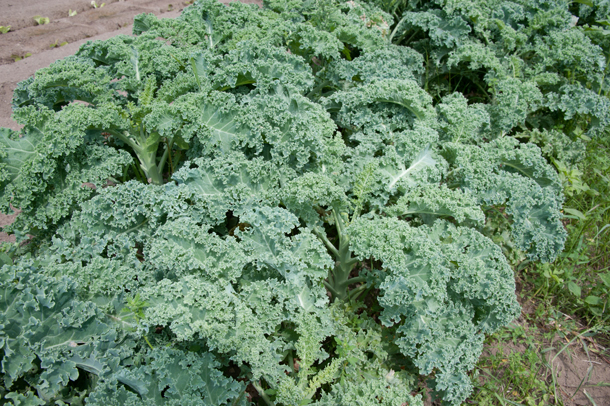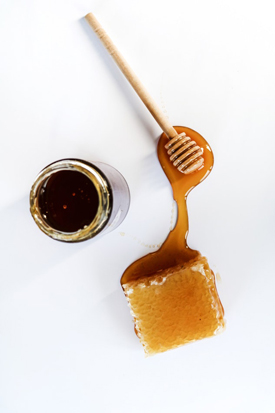Beyond the Headlines
Air Date: Week of March 29, 2019

Kale is a new arrival on the “Dirty Dozen” list of produce with high pesticide levels compiled by the Environmental Working Group. (Photo: Dwight Sipler, Flickr, CC BY 2.0)
This week in beyond the headlines, Peter Dykstra joins Host Steve Curwood to discuss how kale is now on the “Dirty Dozen” list of produce with high levels of pesticides, according to the Environmental Working Group. In other pesticide news, they talk about how glyphosate is now a hot commodity for lawyers. Glyphosate is also being found in Canadian honey samples. And from the history vaults, they take a look back an early study of plastic pollution in the oceans and note a whale recently washed up in the Philippines with 88 pounds of plastic in its belly.
Transcript
CURWOOD: Time now to take a look beyond the headlines with Peter Dykstra. Peter’s an editor with Environmental Health News. That's ehn.org and daily climate.org. And he's on the line now from Atlanta, Georgia, at least I think so. Hey, Peter, are you there?
DYKSTRA: How you doing, Steve? We're going to talk a little bit about the Environmental Working Groups annual dirty dozen list of produce that has some pesticide risk. They have usual suspects on the list each year like strawberries and apples and spinach, but there's a new extremely trendy newcomer that's in there; kale.
CURWOOD: Oh, Peter say it's not so! I just had a kale bowl.
DYKSTRA: At least you didn't have a kale burger. I don't know if that exists yet. But kale is often grown with use of chemical called DCPA. It's also known as Dacthal. Dacthal was in 2009 prohibited from all uses in the European Union as early as 1995. The US EPA identified Dacthal as a possible carcinogen, and it's still used on a number of food crops, not just kale! But, broccoli, sweet potatoes, eggplant, and something I tend to avoid; turnips.
CURWOOD: Hmm, so what's to be done?
DYKSTRA: Rinse your kale well. Rinse the other vegetables in the list well. And I want to apologize because I know somewhere out there among the Living on Earth listenership somebody just had a sip of a kale smoothie, and it probably didn't go down very well.
CURWOOD: Hey, what else do you have for us today?
DYKSTRA: You know, those whiplash, lawyer TV ads that look for victims of car wrecks or defective consumer products?
CURWOOD: Oh, yeah.
DYKSTRA: At EHN we found the piece last week on a Canadian study that found traces of glyphosate in 98% of the samples of Canadian honey. Glyphosate is another whiplash lawyer specialty lately; those commercials are starting to show up. There was a second study that found glyphosate residue and 27% of the honey in Hawaiian hives say that quick three times honey in Hawaiian hives.

Glyphosate was found in 98% of Canadian Honey in a recent study (Photo: Photo: Unsplash, Courtesy of Danika Perkinson)
CURWOOD: So, why are lawyers so interested in this?
DYKSTRA: There are a number of cases in litigation right now and they're inspired by an immense award by a jury to a man who said he was a victim of glyphosate. He was a groundskeeper who regularly used the herbicide in his landscaping work. The jury found that that was a cause of his Non-Hodgkin’s Lymphoma. The initial award was about a quarter of a billion dollars- the court later reduced that to a mere 10s of millions of dollars but still that's catnip to trial lawyers.
CURWOOD: Indeed, hey what do you have from the history of vaults for us?
DYKSTRA: 30 years ago, some NOAA scientists presented on plastics in the ocean. It reported on growing amounts of plastic waste in the Pacific, something we now know 30 years later as the great pacific garbage patch.
CURWOOD: Hmm. So, it seems to be more and more of the stuff. What's to be done?
DYKSTRA: Well, that first report dealt with plastic waste in the Pacific. Today, we call it the Great Pacific Garbage Patch. There are a lot of one-off efforts underway to ban single use plastics, or grocery bags, or straws. But the problem is immense. We're finding plastics not just in the Pacific, but in every ocean of the world, including the Arctic, freshwater rivers and streams, including the Great Lakes. And here's a kind of a tragic Guinness Book of World Records type of thing that I read this past week. In the Philippines, there was a carcass of a beaked whale. A beaked whale is kind of a large size dolphin. It was found on a Philippines beach, they did a necropsy, they cut the beaked whale open, and they found 88 pounds of plastic, mostly plastic bags.
CURWOOD: Hmm. Well, thanks, Peter. Peter's an editor with Environmental Health News, that's ehn.org, and dailyclimate.org. We'll talk again real soon.
DYKSTRA: All right, Steve, thanks a lot. Talk to you soon.
CURWOOD: And there's more on these stories at our website, loe.org.
Links
Environmental Working Group | “EWG’s 2019 Shopper’s Guide to Pesticides in Produce”
Environmental Health News | “Weed Killer Residues Found in 98 Percent of Canadian Honey Samples”
“The Quantitative Distribution and Characteristics of Neuston Plastic in the North Pacific Ocean”
Live Science | "Dead Whale Washes Ashore with Shocking 88 lbs. of Plastic in Its Stomach”
Living on Earth wants to hear from you!
Living on Earth
62 Calef Highway, Suite 212
Lee, NH 03861
Telephone: 617-287-4121
E-mail: comments@loe.org
Newsletter [Click here]
Donate to Living on Earth!
Living on Earth is an independent media program and relies entirely on contributions from listeners and institutions supporting public service. Please donate now to preserve an independent environmental voice.
NewsletterLiving on Earth offers a weekly delivery of the show's rundown to your mailbox. Sign up for our newsletter today!
 Sailors For The Sea: Be the change you want to sea.
Sailors For The Sea: Be the change you want to sea.
 The Grantham Foundation for the Protection of the Environment: Committed to protecting and improving the health of the global environment.
The Grantham Foundation for the Protection of the Environment: Committed to protecting and improving the health of the global environment.
 Contribute to Living on Earth and receive, as our gift to you, an archival print of one of Mark Seth Lender's extraordinary wildlife photographs. Follow the link to see Mark's current collection of photographs.
Contribute to Living on Earth and receive, as our gift to you, an archival print of one of Mark Seth Lender's extraordinary wildlife photographs. Follow the link to see Mark's current collection of photographs.
 Buy a signed copy of Mark Seth Lender's book Smeagull the Seagull & support Living on Earth
Buy a signed copy of Mark Seth Lender's book Smeagull the Seagull & support Living on Earth

